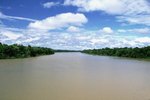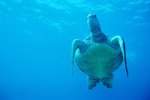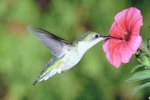The respiratory system delivers oxygen to the cardiovascular system and removes carbon dioxide from the body. Each creature's respiratory system is tailored to his own oxygen needs; some have lungs and some don't. Among those with lungs, respiratory system's elements vary according to animal type. Amphibians, for instance, have rudimentary lungs since they tend to have a low demand for oxygen, while birds, who require lots of oxygen to fly, have more complicated lung structure.
Amphibian Lungs
Most amphibians start life in the water, using gills to breathe -- and tadpoles actually use their tail fins. In most cases, as they grow, their gills deteriorate and their lungs develop. Lung structure varies even among amphibians, but often their lungs are basically empty sacs. A few amphibians have lungs with alveoli, the little balloonlike structures that in many species transfer oxygen between the lungs and the bloodstream. Amphibians don't have diaphragms to move air into the lungs; instead, they use their mouths to force air into their lungs. Amphibians using lungs to breathe include frogs, toads, salamanders and newts.
Tips
Amphibians can also take in oxygen through their thin skin.
Reptile Lungs
Reptiles have more complicated lung structures than amphibians, because they rely primarily on their lungs to for gas exchange. Reptiles don't have diaphragms to inflate their lungs; most expand their body walls and rib cages to take in air. Crocodiles and alligators inflate their lungs via a special muscle attached to their livers. Reptiles with lungs include crocodiles, alligators, turtles, tortoises and snakes.
Mammal Lungs
Of course, your lungs aren't quite like your dog's or cat's lungs, but the premise is the same. Mammalian lungs are filled with alveoli that increase the lungs' surface area according to the animal's needs, and they're powered by a diaphragm. Dogs, cats, horses, cattle, sheep, pigs, monkeys, rats and a host of other animals have a similar lung structure to humans.
Bird Lungs
Birds have unique lungs because of their high demand for oxygen. Bird lungs are open-ended, leading to and from special air sacs. The lungs are constantly inflated, accepting airflow in only one direction. Depending on the type of bird, he may have seven or nine air sacs extending into his thigh bones, the bones between his elbow and shoulder, his vertebrae and his skull. The bird's complicated respiratory system requires two cycles -- inspiration, expiration, inspiration, expiration -- to circulate air through his entire respiratory system, compared to the single cycle mammals require. However, a bird's respiratory system is more efficient because it moves more oxygen with each breath.
Fish Lungs
If you think fish don't have lungs, you're mostly correct. The vast majority of fish use gills to breathe; however, the lungfish is the exception, using lungs to breathe air above the water's surface. Some species of lungfish rely only on their lungs for breathing while others also take oxygen from the water through their gills.
References
- Merck Veterinary Manual: Overview of the Respiratory System
- The Lung Association: Got Lungs? Reptiles Respiratory System
- The Lung Association: Got Lungs? Amphibians Respiratory System
- Science Clarified: Amphibians
- Encyclopaedia Britannica: The Respiratory System
- The Lung Association: Got Lungs? Birds Respiratory System
- The Lung Association: Got Lungs? Mammals Respiratory System
- PetEducation.com: Respiratory System of Birds: Anatomy and Function





